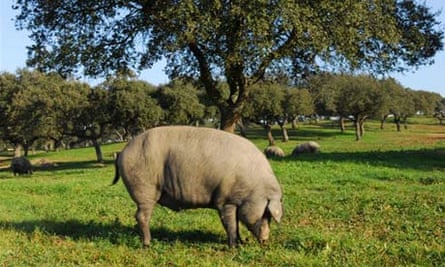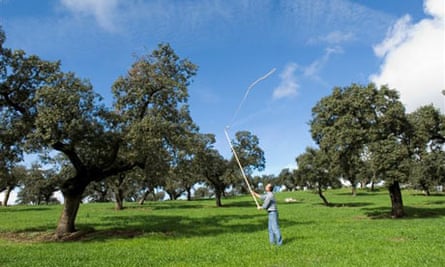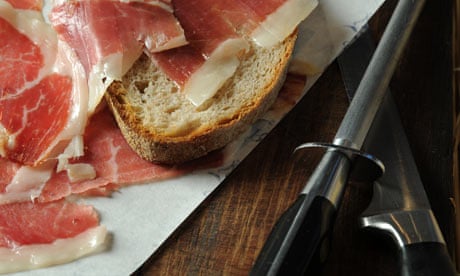It was not the two perfectly fried eggs or the two slices of toast drizzled with olive oil tasting of freshly mown grass which made this one of my more memorable breakfasts. It was the small plate set in front of me by farm owner Felipe Perez Corcho which set my heart racing. It was filled with wafer thin slices of the ruby red wonder which is jamón ibérico de bellota, arguably the greatest item of food in the world. I pierced the soft, golden yolks of the egg with a slice of jamón and allowed it to sit on my tongue as the yellow ribbon of acorn-rich fat began dissolve into savoury bliss. Few food experiences have or ever will match it.
I had received an invitation from the good people of Brindisa, one of Britain's finest importers of Spanish food, to join them on a visit to a new supplier of ibérico ham, Señorio De Montanera, and could hardly contain my excitement. Jamón ibérico has long been my favourite food of all, but I knew little about its production methods or the region in which the legendary ibérico pigs are raised. This was the perfect opportunity to fill that gap in my knowledge and came with the added bonus of an opportunity to eat my own bodyweight in ham.
Spain produces an astonishing 40m hams a year, including excellent varieties of the famous jamón serrano made from the dry-cured legs of the white pig and produced in regions such as Teruel and Trévelez in eastern Spain. But, it is to the west you have to look for the finest jamón, to the vast tracts of land known as the Dehesa, an ecosystem of prairie-like grazing land dotted with encina trees, known as holm oak in English, which once covered almost 90% of the country but now only remains in the regions of Salamanca, Extremadura, Andalucia and across the border into Portugal.
It is here that the black Iberian pigs thrive, snuffling on the dusty ground for sweet acorns (bellota) fallen from the trees. Across in Portugal they are known as "porco de raça Alentejana", but to everyone in Spain, these fat pigs with slender legs are known simply as "pata negra" because of their trademark black hooves.

The production of jamón ibérico is strictly regulated, more so than any other food I had ever encountered. The Denomination of Origin (DO) covers four regions. To the north, Salamanca and the town of Guijuelo, home of Joselito, arguably the most famous name in jamon and certainly the best known to ham lovers in the UK. To the west, the province of Huelva and particularly the town of Jabugo. To the east there is the less well-known denomination of Valle de Los Pedroches and finally, bordering on Andalucia, is the dusty region of Extremadura known also as the home of the conquistadors, Cortez and Pizarro. Although each region would claim that the hams they produce are the finest, the rules which govern their production are the same and the end results indistinguishable to all but the most experienced palate.
It was to the town of Burguillos del Cerro, close to the Portuguese border, where I came to meet Felipe Perez Corcho. He is one of the founder shareholders of Señorio De Montanera, a collective of 72 farmers who, since 1992, have produced some of the finest jamón ibérico de bellota in Spain. As soon as we had deposited our bags in the rambling farmhouse Felipe led us across the fields to where the pigs were enjoying the bounty of the oak trees and the wild grass and herbs which also form an important part of their diet.
Iberian piglets are fed on a diet of cereals and acorns until they are nearly 18 months old. The final three months or so of their lives are spent out in the Dehesa during what's known as the montanera, a period from October 1 to January 1 when acorns fall from the oaks. The pigs must feed on enough acorns and reach the DO-specified weight of 160kg to gain the coveted title jamón ibérico de bellota. The regulations also specify that there should be no more than two pigs per hectare of land to ensure that each pig can eat the required amount of between 6 and 7kg of acorns a day.
The acorns from the encina oaks are rich in oleic acid, the same chemical which can be found in olives. The flavour finds its way into the fat of the animal, so much so that the locals refer to Iberian pigs as "olives with legs".

Once the Montanera has run its course the animals are taken to nearby abattoirs for slaughter (or 'sacrifice' as its referred to in the region) which is done in such a way as to induce as little stress in the animals as possible. The regulations of the DO include how the pigs are kept, killed and butchered and are rigorously enforced. Only if the exacting standards are met will the inspector allow the meat to be tagged with the mark confirming they have made the grade. If they fail, the hams can still be sold as jamón ibérico but are not allowed to carry the coveted suffix "de bellota".
The curing and ageing of the hams is no less important than the rearing and butchering of the animals. The front legs, the paletas, and the rear legs, the jamones, are chilled overnight to allow them to firm and then covered in Andalucian sea salt for approximately one day per kilo of weight. They are then washed and hung to dry allowing the natural flora to form on the surface. This final part of the curing process can take up to three years, after which they are ready for sale. But not before one final check from the DO inspectors, who test the hams one more time by inserting a sharpened beef bone and sniffing to check the quality of the cure.
The results of this five year journey from the Dehesa to the plate are incomparable. The oleic acid in the acorns on which the pig feeds makes the fat of the jamón ibérico de bellota one of the truly magical tastes sensations as it dissolves in your mouth. The depth of flavour in the meat is like no other and the combination lingers like a fine wine.
Jamón ibérico and its related products are truly an experience not to be missed. However, the range available and its labelling can be confusing, so here is a simple guide.
Jamón
There are four grades of jamón ibérico, categorised primarily by the diet of the pigs. The curing process remains the same, but the length for which they are aged will differ with the lower grade hams receiving little more than a year of hanging and the very best up to four years.
The age difference can be seen in the finished result with the flesh of the younger hams having a lighter pink colour and those of older hams being a deep, ruby red. The taste too is very different with the acorn richness of the jamón ibérico de bellota lingering on the palate like a fine wine.
Jamón ibérico de bellota
From pure Iberico pigs fed on a diet of acorns during the Montanera and granted DO status. These hams are aged for at least three years before being released and often labelled 'reserva' and 'gran reserva' to denote their age.
Jamón ibérico de recebo
Fed on a diet of cereals and acorns and aged for at least three years.
Jamón ibérico cebo de campo
Free range, but fed only on a diet of cereals.
Jamón ibérico de cebo
Commercially reared pigs fed on a diet of cereals.
It is also worth sampling these excellent Serrano hams.
Jamón de Trévelez
Produced from white pigs which have been fed on commercial cereals, this is still a very fine ham, which fans say has a sweetness that comes from the climate in which the pigs are reared.
Jamón de Teruel
The first jamon in Spain to receive DO status, these mountain hams must be aged for at least 12 months after curing before being sold.
Embutidos
Worry not, the rest of the pig is not wasted and these other cured products are also well worth seeking out.
Chorizo de cerdo ibérico
A cured sausage made from chopped pork, pork fat and paprika. There are hundreds of regional varieties, some containing garlic and herbs.
Lomo de cerdo ibérico
The cured tenderloin of the pig. Señorio De Montanera make a stunning version covered in lard made from the fat surrounding the pig's kidneys.
Salsichon de cerdo ibérico
Another sausage, cured for at least four months.
Morcon de cerdo ibérico
A larger, less well known sausage cured with herbs and spices.
